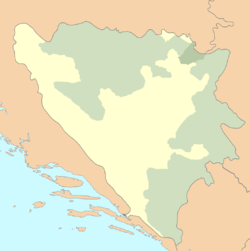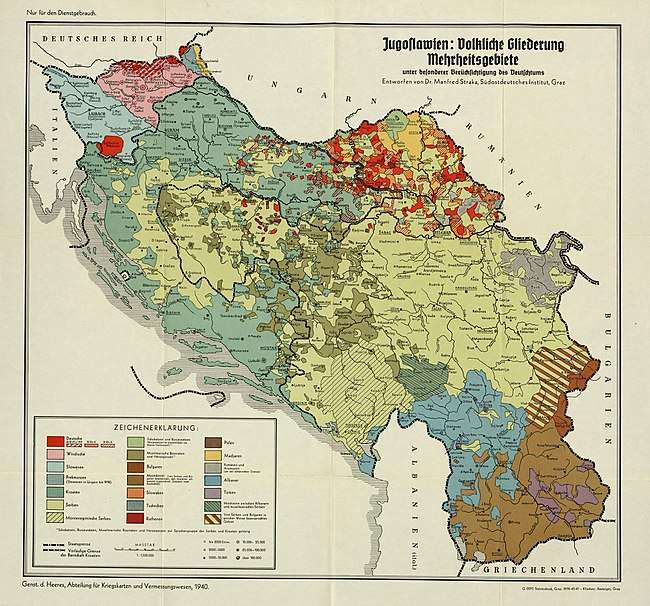Croats of Bosnia and Herzegovina
The Croats of Bosnia and Herzegovina, often referred as Bosnian or Herzegovinian Croats, are the third most populous ethnic group in the country after Bosniaks and Serbs, and are one of the constitutive nations of Bosnia and Herzegovina.[1] Croats of Bosnia and Herzegovina have made significant contributions to the culture of Bosnia and Herzegovina. Most Croats declare themselves Roman Catholics and speakers of Croatian.
 Painting depicting group of Croats harvesting the field | |
| Total population | |
|---|---|
| 544,780 (2013) | |
| Languages | |
| Croatian | |
| Religion | |
| Roman Catholic | |
| Related ethnic groups | |
| Primarily Croats other South Slavs |
| Part of a series on |
| Croats |
|---|
 |
|
Subgroups |
From the 15th to the 19th century, Catholics in modern-day Bosnia and Herzegovina were often persecuted under the Ottoman Empire, causing many of them to flee the area. In the 20th century, political turmoil and poor economic conditions caused more to emigrate. Ethnic cleansing within Bosnia and Herzegovina in the 1990s saw Croats forced to different parts of Bosnia-Herzegovina, although having lived in numerous regions prior to the Bosnian War. According to the report by the Bosnia and Herzegovina statistics office, on the census of 2013 there were 544,780 Croats living in Bosnia and Herzegovina.[2]
History
Kingdom of Croatia
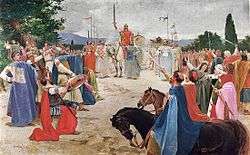
Croats settled the areas of modern Croatia and Bosnia and Herzegovina in the 7th century.[3][4][5]Constantine VII in De Administrando Imperio writes that Croats settled Dalmatia and from there they settled Illyricum and Pannonia[6] There, they assimilated with native Illyrians and Romans during the great migration of the Slavs.[4][7] The Croats adopted Christianity and began to develop their own culture, art, and political institutions, culminating in their own kingdom, which consisted of two principalities: Pannonian Croatia in the north, and Dalmatian Croatia in the south. Red Croatia, to the south, was land of a few minor states. One of the most important events of the Croats in Bosnia and Herzegovina in the early Middle Ages is the First Croatian Assembly held in 753 in Županjac (present-day Tomislavgrad).[8] The second major event was the coronation of Tomislav, the first King of Croatia, in ca. 925, in the fields of Županjac.[9] By this act, Pannonian Croatia and Dalmatian Croatia formed a united Croatian kingdom, which included Dalmatia, Bosnia[10][11][12] and Pannonia (eastern Slavonia and eastern Bosnia), and Savia (western Slavonia).[4]
High and late middle age
In 1102 Croatia entered into a union with the Kingdom of Hungary. After this, Bosnia, which was earlier part of the Kingdom of Croatia,[13] started to disassociate with Croatia. At first, Bosnia became a separate principality under Ban Kulin who managed to solidify Bosnian autonomy at the expense of more powerful neighbours, but only in the 14th century did Bosnia become a formidable state. In the 14th century, King Tvrtko I conquered part of western Serbia and later parts of the Kingdom of Croatia,[14] which he accomplished by defeating various Croatian nobles and supporting Hungary.[15] Thus, the Kingdom of Bosnia emerged, but part of present territory of Bosnia and Herzegovina remained in the Kingdom of Croatia.
Regarding to culture and religion, Bosnia was closer to Croatia than the Orthodox lands to the east, and the Diocese of Bosnia is mentioned as Catholic in the 11th century, and later fell under the jurisdiction of the croatian Archdiocese of Split and in the 12th Century under the jurisdiction of the Diocese of Dubrovnik. Another connection of Bosnia with Croatia is that Bosnian rulers always used the political title "Ban Kulin" in similarity with their Croatian counterparts.[16] The specific religion in medieval Bosnia was Bogomilism and Bosnian Church, so some of the notable feudal lords in Medieval Bosnia were followers of this religion, such as Duke Hrvoje Hrvatinić.[17] Due to the scarcity of historical records, there are no definite figures dealing with the religious composition of medieval Bosnia. However, some Croat scholars suggest that a majority of Bosnia's medieval population were Catholics who, according to Zlopaša, accounted for 700,000 of 900,000 of the total Bosnian population. Some 100,000 were Bogomils and other 100,000 were Orthodox Christians.[18]
Ottoman Empire

In the middle of the 15th century, the Ottoman Empire started to conquer Bosnia. In 1451 they took Vrhbosna province and conquered Bosnia in 1463. Herzegovina was conquered in 1481, while northern Bosnia was still under Hungary and Croatia until 1527, when it was conquered by the Ottomans.[19] After the Turkish conquest, many Catholic Bosnians converted to Islam,[20] and their numbers in some areas shrank as many fled from fear of conversion and persecution. The Ottoman conquest changed the demographics of Bosnia and Herzegovina, reducing the number of Catholics, and eliminating the Bosnian Church, whose members apparently converted to Islam en masse.[18] The present-day boundaries of Bosnia and Herzegovina were made in 1699, when the Treaty of Karlowitz was signed in order to establish peace between the Austrian Empire and the Ottoman Empire. Another significant event for Bosnian Croats is the boundary established by an agreement between the Republic of Ragusa and the Ottoman Empire, where Ragusans promised to give in part of their territory in Neum to the Ottomans in order to protect themselves from the Republic of Venice.[21]
The activity of the Catholic Church was limited, while the Ottomans preferred the Orthodox Church because Catholicism was the faith of Austria, the Ottoman enemies, while Orthodoxy was common in Bosnia, and thus it was more acceptable to the Ottomans. In the first 50 years of Ottoman rule, many Catholics fled from Bosnia.[22] A number of Catholics also converted to Orthodox Christianity.[23] Franciscans were only Catholic priests to be active in Bosnia. Before the Ottomans arrived in Bosnia, there was 35 Franciscan monasteries in Bosnia and four in Herzegovina. Some monasteries were destroyed and some were converted to mosques. In the 1680s there were only 10 Franciscan monasteries left in Bosnia. The Catholic Church in Bosnia divided its administration into two dioceses, one was the Croatian Bosnia diocese, part which was not conquered by the Ottomans, and other was Bosna Srebrena diocese.[24]
Between 1516 and 1524, a planned persecution and forced Islamization of Catholics occurred in Bosnia and Herzegovina.[25] In that year, Franciscan monasteries in Kraljeva Sutjeska, Visoko, Fojnica, Kreševo and Konjic, and later in Mostar. It is believed that during that time, some 100,000 Croats converted to Islam. In 1528 the Ottomans conquered Jajce and Banja Luka, thus destroying the Croatian defence line on Vrbas river. After that conquest, Croatia reduced to around 37,000 km². During the 18th century, Turkish rule in Bosnia and Herzegovina started to weaken, and after the Napoleonic Wars their rule rapidly decreased; the Ottoman Empire lost its demographic, civilization, and other reserves for military and territorial expansion, while the Austrian Empire, as the rest of the European countries, gained them.
From 1815 to 1878 the Ottoman's authority in Bosnia and Herzegovina was decreasing. After the reorganization of the Ottoman army and abolition of the Jannisaries, Bosnian nobility revolted, led by Husein Gradaščević, who wanted to establish autonomy in Bosnia and Herzegovina and to stop any further social reforms. During the 19th Century, various reforms were made in order to increase freedom of religion which sharpened relations between of Catholics and Muslims in Bosnia and Herzegovina. Soon, economic decay would happen and nationalist influence from Europe came to Bosnia and Herzegovina. Since the state administration was very disorganized and the national conscience was very strong among the Christian population, the Ottoman Empire lost control over Bosnia and Herzegovina. On 19 June 1875 Catholic Croats, led by Don Ivan Musić,[26] revolted because of high taxes in West Herzegovina. Their goal was to subordinate Bosnia to the rule of the Emperor of Austria, respectively King of Croatia. During the revolt, for the first time Bosnian Croats used the flag of Croatia.[27] Soon after, the Orthodox population in East Herzegovina also revolted, which led to the Herzegovina Uprising. The Ottoman authorities were unable to defeat the rebels, so Serbia and Montenegro took advantage of this weakness and attacked the Ottoman Empire in 1876, soon after the Russian Empire did the same. The Turks lost the war in 1878, and this resulted in over 150,000 refugees who went to Croatia.[28] After the Congress of Berlin was held in the same year, Bosnia and Herzegovina was transferred to the Austro-Hungarian Empire.[29]
Austria-Hungary
Even after the fall of the Ottoman rule, the population of Bosnia and Herzegovina was divided.[30] In the Habsburg Kingdom of Croatia, Croatian politicians strived for the unification of the Kingdom of Dalmatia with Croatia. Another ambition of Croatian politicians was to incorporate the Condominium of Bosnia and Herzegovina into the Kingdom of Croatia. The Habsburg Governor Béni Kállay resorted to co-opt religious institutions. Soon, the Austrian Emperor gained support to name Orthodox metropolitans and Catholic bishops and to choose Muslim hierarchy.[31] The first Catholic archbishop was Josip Stadler.[32] Both apostolic vicarates, Bosnian and Herzegovinian, were abolished, and instead three dioceses were founded; Vrhbosna diocese with a seat in Sarajevo, Banja Luka diocese with a seat in Banja Luka and Mostar-Duvno diocese with a seat in Mostar.
At the time, Bosnia and Herzegovina was facing a Habsburg attempt at modernization. Between 180,000 and 200,000 people inhabited Bosnia and Herzegovina, the majority were Croats, Serbs, Muslims and in smaller percentages Slovenes, Czechs and others.[31] During this period, the most significant event is Bosnian entry to European political life and the shaping of ethnic Croats in Bosnia and Herzegovina into a modern nation. At the end of the 19th century, Bosnian Croats founded various reading, cultural and singing societies, and at the beginning of the 20th century, a new Bosnian Croat intelligentsia played a major role in the political life of Croats. The Croatian Support Society for Needs of Students of Middle Schools and High Schools in Bosnia and Herzegovina was founded in 1902, and in 1907 it was merged with Croatian Society for Education of Children in Craft and Trade, also founded in 1902, into Croatian Cultural Society Napredak (Progress). Napredak educated and gave scholarships to more than 20,000 students. Students of Napredak were not only Bosnian Croats, but also Croats from other regions.[33]
Kallay tried to unify all Bosnians into a single nation of Bosniaks, but he failed to do so after Bosnians created their national political parties.[31] Before the annexation of Bosnia and Herzegovina in 1908, the Croat People's Union (HNZ) become a political party; its ideology was very similar to that of the Croatian-Serbian Coalition in Croatia. In 1909, Stadler opposed such a policy and founded a new political party, the Croat Catholic Association (HKU), an opponent of the secular HNZ. HKU emphasized clerical ideals and religious exclusivity.[34] However, Bosnian Croats mostly supported the secular nationalist policy of the HNZ.[35] HNZ and Muslim Nation Organization formed a coalition which ruled the country from 1911 until the dissolution of the Bosnian parliament in 1914.[36]
Kingdom of Yugoslavia
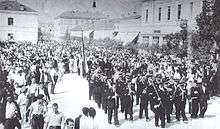
After World War I, Bosnia and Herzegovina became part of the internationally unrecognized State of Slovenes, Croats and Serbs which existed between October and December 1918. In December 1918, this state united with the Kingdom of Serbia as Kingdom of Serbs, Croats and Slovenes,[37]which was renamed the Kingdom of Yugoslavia in 1929.[38] This new state was characterized by Serbian nationalism, and was a form of "Greater Serbia". Serbs held control over armed forces and politics of the state.[39] With around 40% Serbs living in Bosnia and Herzegovina, Serbian leadership of the state wanted to implement a Serbian hegemony in this region. Bosnian Croats constituted around a quarter of the total Bosnian population, but they did not have a single municipality president.[40] The regime of the Kingdom of Yugoslavia was characterized by limited parliamentarism, drastic elective manipulations and later King Alexander's 6 January Dictatorship, state robbery present outside Serbia and political killings (Milan Šufflay, Ivo Pilar) and corruption. Yugoslavia was preoccupied with political struggles, which led to the collapse of the state after Dušan Simović organized a coup in March 1941 and after which Nazi Germany invaded Yugoslavia.
King Alexander was killed in 1934, which led to the end of dictatorship. In 1939, faced with killings, corruption scandals, violence and the failure of centralized policy, the Serbian leadership agreed a compromise with Croats. On 24 August 1939, the president of the Croatian Peasant Party, Vladko Maček and Dragiša Cvetković made an agreement (Cvetković-Maček agreement) according to which Banovina of Croatia was created on territory of Sava and Littoral Banovina and on districts of Dubrovnik, Šid, Brčko, Ilok, Gradačac, Derventa, Travnik and Fojnica. Around 30% of the present-day territory of Bosnia and Herzegovina become part of Banovina of Croatia. Those parts had a Croatian majority. Creation of Banovina of Croatia was one of the solutions to the "Croatian issue".[41]
World War II

After the collapse of Yugoslavia amidst German and Italian invasion in April 1941, the Axis puppet state which encompassed the entire Bosnia and Herzegovina, Independent State of Croatia (NDH) under the radical Croat nationalist ustaša regime was established. Bosnian Croats were divided, as some supported NDH, some actively opposed it by joining or supporting the Yugoslav Partisans, while others chose to wait, not attracted either by fascist ustaše or communist-led resistance. After ustaše campaign of ethnic cleansing and terror, targeting Serbs, Jews, and Roma, a brutal civil war ensued. Ustaše regime also persecuted any opponents or dissidents among Bosnian Croats, especially communists, pre-war members of the now-banned Croatian Peasant Party, and those connected with the partisan resistance. Ustaše executed many Bosnian Croats, for instance, resistance fighters and supporters Jakov Dugandžić, Mostar's Ljubo Brešan[42] and 19-year old Mostar gymnasium student Ante Zuanić,[43] as well as a prominent Mostar CPP member Blaž Slišković (in Jasenovac concentration camp).[44] Prominent Croat communist intellectual from Bosnia, Ognjen Prica, was shot by Ustaše in Kerestinec prison. Families of Bosnian Croats who left to join the partisan resistance were usually interned or sent to concentration camps by ustase authorities.[45]
Numerous Bosnian Croats joined the partisan movement, fighting against the Axis forces and ustaše regime. Some of them included people's heroes such as Franjo Kluz, Ivan Marković Irac, Stipe Đerek, Karlo Batko, Ante Šarić "Rade Španac" and others. From the very beginning of the uprising against the Axis, many Bosnian Croats became commanders of partisan units (e.g., Josip Mažar-Šoša, Ivica Marušić-Ratko etc.), even though the units themselves were predominantly composed of Serbs.[46] The territory that partisans liberated and managed to keep under their control from November 1942 to January 1943 (dubbed the Republic of Bihać) included all of rural Western Herzegovina west of Neretva and Široki Brijeg, including Livno. Livno and its area, under partisan control from August to October 1942, was very important for Bosnian Croat resistance, as key CPP members Florijan Sučić and Ivan Pelivan joined the resistance and mobilized many other Croats.[47] Bosnian Croats' representatives, among which Mostar lawyer Cvitan Spužević, also actively participated in the provisional assembly of the country, ZAVNOBiH (State Anti-fascist Council for the National Liberation of Bosnia and Herzegovina). ZAVNOBiH proclaimed the statehood of Bosnia-Herzegovina and equality of Bosniaks, Croats and Serbs in the country in its historic session in 1943. The first government of People's Republic of Bosnia and Herzegovina in 1945 included several prominent Croats - Jakov Grgurić (deputy prime minister), Cvitan Spužević (minister of construction), Ante Babić (education), and Ante Martinović (forestry).[48][49]
After the partisans liberated most of Yugoslavia and NDH collapsed in May 1945, some NDH soldiers and civilians retreated towards the British-occupied zone in Austria near Bleiburg. Many of them were killed by the Yugoslav partisans after the Bleiburg repatriations.[50] In the closing stages of the war and the immediate aftermath, some Bosnian Croats who previously supported the ustaše regime or were merely perceived as potential opponents of the new communist Yugoslavia were persecuted or executed (notably, Herzegovina friars).
Total casualties and losses of Bosnian Croats in the WWII and the aftermath are estimated at 64-79.000.[51] According to Vladimir Žerjavić, 17.000 Bosnian Croats died in partisan ranks, 22.000 in NDH forces, while 25.000 lost their lives as civilians; of civilians, almost ¾ or 19.000 died as a result of Axis terror or in ustaše concentration camps.[52]
At the end of 1977, 8.8% of Bosnian recipients of veteran's pensions were Croats,[53] while during the WWII Croats composed around 23% of the country's population.
Socialist Yugoslavia
After the war, Bosnia and Herzegovina became one of the 6 constitutive republics of Socialist Yugoslavia. Intensive state campaign of nationalization of property, followed by industrialization and urbanization variously affected Bosnian Croats. While some centers and areas prospered, other rural areas underwent depopulation and urban flight, as well as (most notably western Herzegovina) high rates of emigration to the Western world.
Office holders usually rotated among the three ethnic communities in Bosnia and Herzegovina. In the 1980s, many Bosnian Croat politicians were in high positions - for instance, Ante Marković, Branko Mikulić, and Mato Andrić.
Bosnian War

Citizens of the Socialist Republic of Bosnia and Herzegovina voted for the independence of Bosnia and Herzegovina in the referendum that was held between 29 February and 1 March 1992.[54] The referendum question was: "Are you in favor of a sovereign and independent Bosnia-Herzegovina, a state of equal citizens and nations of Muslims, Serbs, Croats and others who live in it?"[55] Independence was strongly favoured by Bosniak and Bosnian Croat voters, but the referendum was largely boycotted by Bosnian Serbs. The total turn out of voters was 63.6% of which 99.7% voted for the independence of Bosnia and Herzegovina.[56]
On 5 April 1992, Serb forces started the Siege of Sarajevo. On 12 May, Yugoslav People's Army left Bosnia and Herzegovina and left most of the arms to the Army of Republika Srpska, headed by Ratko Mladić. The first unit to oppose Serb forces in Bosnia and Herzegovina was the Croatian Defence Forces (HOS) founded by Croatian Party of Rights of Bosnia and Herzegovina on 18 December 1991.[57] The Croatian Community of Herzeg-Bosnia established its own force, the Croatian Defence Council (HVO) on 8 April 1992. HVO consisted from 20-30% of Bosniaks who joined HVO because local Muslim militias were unable to arm themselves.[58] Croatian Community of Herzeg-Bosnia was founded on 18 November 1991 as a community of municipalities where majority of population were Croats. In its founding acts, Herzeg-Bosnia had no separatist character. The Croatian Republic of Herzeg-Bosnia was declared by the Bosnian Croat leadership as a temporary region, which after war ended, would again become part of a united Bosnia and Herzegovina.[59]
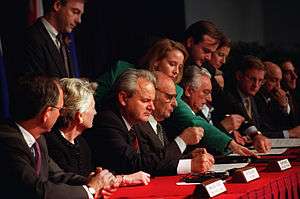
At the beginning of the Bosnian War, Bosnian Croats were first to organize themselves, especially Croats in western Herzegovina who were already armed. At the end of May 1992, Croats launched a counter-offensive, liberating Mostar after a month of fighting.[60] Also, in central Bosnia and Posavina, Croatian forces stopped the Serbian advance, and in some places they repelled the enemy. On 16 June 1992, President of Croatia, Franjo Tuđman and President of Bosnia and Herzegovina, Alija Izetbegović signed an alliance according to which, Bosnia and Herzegovina legalized the activity of Croatian Army and Croatian Defence Council on its territory. Bosnian Croat political leadership and the leadership of Croatia urged Izetbegović to form a confederation between Bosnia and Herzegovina and Croatia, but Izetbegović denied this since he tried to represent Serbian interests as well as those of Bosniaks and Croats. The Bosnian Croat leadership was irritated by Izetbegović's neutrality, so Mate Boban threatened to pull back the HVO from actions in Bosnia.[59] Since the UN implemented embargo to Bosnia and Herzegovina on the import of arms, Bosniak and Croat forces had difficulties fighting Serbian units, which were supplied with arms from the Middle East, just before the outbreak of war. However, after Croat and Bosniak forces reorganized in late May 1992, the Serbian advance was halted and their forces mostly remained in their positions during the war.[61] The tensions between Croats and Bosniaks started on 19 June 1992, but the real war began in October.
The Croat-Bosniak War was at its peak during 1993. In March 1994, the Bosniak and Croat leadership signed the Washington agreement, according to which, the Army of the Republic of Bosnia and Herzegovina (ARBiH)-controlled and HVO-controlled areas were united into the Federation of Bosnia and Herzegovina. After the Washington agreement was signed, the Croatian Army, HVO and ARBiH liberated southwestern Bosnia and Herzegovina in seven military operations. In December 1995, the Bosnian War ended with the signing of the Dayton agreement. However, the same agreement caused problem in Bosnia and Herzegovina, and was largely ineffective. According to the information published by the Research and Documentation Centre in Sarajevo, 7,762 Croats were killed or missing. From the territory of the Federation of Bosnia and Herzegovina, 230,000 Croats were expelled, while from territory of Republika Srpska, 152,856 Croats were expelled.[62]
Demographics
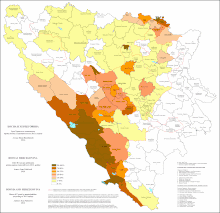
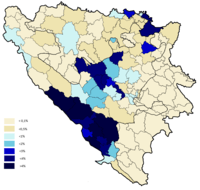
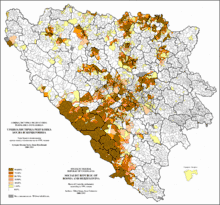
Comprising 15.43% of the country's population, Croats have been unequally spread across the area of Bosnia and Herzegovina. This has further been reflected and reinforced by the post-1995 political division of the country. Currently, according to the 2013 census, 91% of them live in the Federation of Bosnia and Herzegovina, while just 5.4% and 3.2% live in Republika Srpska and Brčko District, respectively. In RS, Croat share in the entity population is just 2% (29,645), while in Brčko it stands at 20.7% (17,252). On the other hand, in the Federation Croats form 22.4% of the entity population. Four out of ten Federation's cantons have Croat majority. All Croat-majority municipalities are located in this entity as well.
Municipalities
However, Croats are further variously spread in the Federation itself. Most of the municipalities with a clear Croat majority form two compact regions. One is in the southwest of the country, along the border with Croatia, from Kupres and Livno in the northwest along West Herzegovina to Ravno in the southeast (Široki Brijeg, Ljubuški, Livno, Čitluk, Tomislavgrad, Čapljina, Posušje, Grude, Prozor-Rama, Stolac, Neum, Kupres, Ravno). Around 40% of country's and 45% of Federation's Croats live here. The second is Posavina Canton in the north (Orašje, Odžak, Domaljevac-Šamac). This canton's share in the Croat population is 6%. Other Croat-majority or -plurality municipalities are enclaves in Central Bosnia and around Zenica (Dobretići, Vitez, Busovača, Kiseljak, Usora, Kreševo, Žepče). In ethnically mixed Jajce and Novi Travnik in Central Bosnia, Croats form around half of the population.
In Mostar area, Croats comprise the plurality of the population both in the municipality (48.4%) and the city itself (49%).[63] Mostar is the largest city in Herzegovina and the city with the largest Croat population in the country (51,216 in the area and 29,475 in the urban district). Croats comprise an overwhelming majority in the western part of both the city and the entire municipality.[63]
Croats comprise 41% of the population in Uskoplje, a third in Vareš and Pelagićevo, and a quarter in Glamoč and Donji Žabar. In Grahovo, Croats make around 15% of the population.
In addition to that, 762 Croats form the plurality (40.4%) in an ethnically diverse small town Glamoč.[64]
Cantons
There are 4 Croat-majority cantons and in total 6 cantons in which Croats form more than 10% of the population.
| Canton | Croats | % | Share in total Croat population |
|---|---|---|---|
| West Herzegovina | 93,783 | 96.82% | 17.21% |
| Canton 10 | 64,604 | 76.79% | 11.86% |
| Posavina Canton | 33,600 | 77.32% | 6.17% |
| Central Bosnia Canton | 97,629 | 38.33% | 17.92% |
| Herzegovina-Neretva Canton | 118,297 | 53.29% | 21.71% |
| Zenica-Doboj Canton | 43,819 | 12.02% | 8.04% |
Demographic history
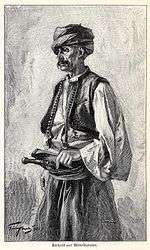
| Ethnic totals and percentages | |||||||||||||
| Year/Population | Croats | % | Total BiH Population | ||||||||||
|---|---|---|---|---|---|---|---|---|---|---|---|---|---|
| 1921 | 444,308 | 23.50% | 1,890,440 | ||||||||||
| 1931 | 547,949 | 23.58% | 2,323,555 | ||||||||||
| 1948 | 614,123 | 23.93% | 2,565,277 | ||||||||||
| 1953 | 654,229 | 22.97% | 2,847,790 | ||||||||||
| 1961 | 711,666 | 21.71% | 3,277,948 | ||||||||||
| 1971 | 772,491 | 20.62% | 3,746,111 | ||||||||||
| 1981 | 758,140 | 18.39% | 4,124.008 | ||||||||||
| 1991 | 760,852 | 17.38% | 4,377,053 | ||||||||||
| 2013 | 544,780 | 15.43% | 3,531,159 | ||||||||||
| Official Population Census Results - note: some Croats declared themselves as Yugoslavs in some censuses | |||||||||||||
Ottoman Empire
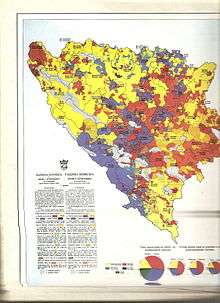
Some estimates state that the population of medieval Bosnia, was between 850,000 - 900,000 inhabitants, of which 750,000 were Catholics (85,22%), 80,000 were Bogomils (9,09%) and 50,000 were Orthodox Christians (5,68%) . During the Ottoman rule, the number of Catholics decreased drastically. When the Turks conquered Bosnia in 1463, according to their data, they took 100,000 Catholics into captivity and 30,000 Catholic boys to serve as janissaries . In 1558/59, in present-day Bosnia and Herzegovina, there were 360,000 Catholics (57%), 220,000 Muslims (34%) and 55,000 Orthodox Christians (9%) . Many Catholics fled to Venetian or Habsburg-ruled lands . In 1624, there was around 450,000 Muslims (67%), 150,000 Catholics (22%) and 75,000 Orthodox Christians (11%).[65] In 1776, according to Klaić, there were around 50,000 Catholics in Bosnia. However, the Turkish censuses were biased, and they only numbered the houses and later exclusively included the male population.[66] Throughout this period, Catholic majority persisted in the southwest of the country (western Herzegovina), parts of central Bosnia, and Posavina, mostly in rural areas.
Austria-Hungary and Kingdom of Yugoslavia
During Austro-Hungarian rule (1878–1918), the number and share of Croats started to slowly increase. Croats from Croatia moved to the country to work in the austro-Hungarian administration or as teachers, doctors and officers. According to the Croatian author Vjekoslav Klaić, at the beginning of the period, in 1878, there were 646,678 Orthodox Christians (respectively Serbs, 48.4%), 480,596 Muslims (35.9%), 207,199 Catholics (respectively Croats, 15.5%) and 3,000 Jews (0.2%).[30] In 1895, Bosnia and Herzegovina had 1,336,091 inhabitants, of which there was 571,250 Orthodox Christians (42.76%), 492,710 Muslims (36,88%), 265,788 Catholics (19.89%), 5,805 Jews (0.43%) and 53 others (0.04%). The slow process of nation-building on one hand and the austro-Hungarian administration's downplaying ethnic differences and nationalism while trying to keep Croatian and Serbian influence on the country at bay on the other hand make it difficult to assess the actual ethnic allegiance at this period.
The main characteristic of the ethnic policy of the Kingdom of Yugoslavia (1918–1941) was a Serbian attempt to implement Serbian hegemony and to serbianize rest of the population. According to the 1931 census, Bosnia and Herzegovina had 2,323,787 inhabitants of which Serbs made 44.25%, Muslims 30.90%, Croats 23.58% and others made 1.02% of the total population.
Communist Yugoslavia
The first Yugoslav census recorded a decreasing number of Croats; from the first census in 1948 to the last one from 1991, the percentage of Croatians decreased from 23% to 17.3%, even though the total number increased. According to the 1953 census, Croats were in the majority in territories which became part of Banovina of Croatia in 1939. Their total number was 654,229, that is 23,00% of total Bosnian population. According to the 1961 census, Croats made up 21.7% of total population, and their number was 711,660. After that, districts were divided into smaller municipalities.
According to the 1971 census, Croats were 20.6% of total population, and their number was 772,491. According to the 1981 census, Croats made up 18.60% of total population, and their number was 767,247. In comparison to the 1971 census, for the first time the percentage of Croats was below 20%, and after 1981, their percentage continued to fall. From 1971 to 1991, the percentage of Croats fell due to emigration into Croatia and Western Europe.[67][68] Nevertheless, the fall in population percentage is only absent in western Herzegovina municipalities where Croats account for more than 98% of the population. According to the 1991 census, Croats were 17.3% of the total population, and their number was 755,895.
Bosnian War
The total number of Croats in Bosnia and Herzegovina continued to fall, especially after the Bosnian War broke out in 1992. Soon, an exodus of Bosnian Croats occurred when a large number of Croats were expelled from central Bosnia and Posavina. According to the 1996 census, made by UNHCR and officially unrecognized, there were 571,317 Croats in the country (14.57%). In the territory of the Herzeg-Bosnia, the percentage of Croats slightly changed, although, their total number was reduced.
Education
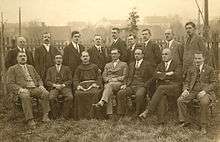
The first education institutions of Bosnian Croats were monasteries, of which the most significant were those in Kreševo, Fojnica, Kraljeva Sutjeska and Tolisa, and later monasteries in Herzegovina, of which most significant are those in Humac and Široki Brijeg. The most significant people working for the elementary education of Bosnian Croats in the 19th century were Ivan Franjo Jukić and Grgo Martić, who founded and organized elementary schools throughout Bosnia and Herzegovina. In 1887, many elementary schools were founded in Bosnia and Herzegovina along with the Order of Sisters of St. Francis, whose classes were led methodologically and professionally, so Bosnian Croat schools were, at the end of Ottoman era and beginning of Austrian-Hungarian occupation, the same as elementary schools in rest of Europe. The educational system of Bosnia and Herzegovina during communism was based on a mixture of nationalities and the suppression of Croat identity. With the foundation of Croatian Community of Herzeg-Bosnia, Bosnian Croat schools took the educational system from Croatia.
At the same time, University Džemal Bijedić of Mostar was renamed to University of Mostar with Croatian as the official language. This university is the only one in Bosnia and Herzegovina to use Croatian as official language. After signing the Dayton accords, jurisdiction over education in Republika Srpska was given to the RS Government, while in the Federation, jurisdiction over education was given to the cantons. In municipalities with a Croat majority or significant minority, schools with Croatian as an official language also exist, while in the territories where there is only a small number of Croats, Catholic centres perform education. Other education institutes are HKD Napredak, Scientific Research Institute of University of Mostar, Croatian Lexicographic Institute of Bosnia and Herzegovina and Institute for Education in Mostar.
Language
Croats of Bosnia and Herzegovina speak Croatian, a standardized variety of Serbo-Croatian language, spoken by the people of Bosnia and Herzegovina. Even though most of them speak in the Ijekavian, also the norm among Bosniaks and Bosnian Serbs, Ikavian is also used and was widespread in larger parts of Bosnia and Herzegovina.
Politics
State level
Croats of Bosnia and Herzegovina, as well as other two constitutive nations, have their representative in the Presidency of Bosnia and Herzegovina. Presidency has three members, one Bosniak, one Croat and one Serb. Bosniak and Croat are elected in the Federation of Bosnia and Herzegovina, while Serb is elected in the Republika Srpska.[69]
Current Croat member of the Presidency is Željko Komšić of the DF.
The Parliamentary Assembly of Bosnia and Herzegovina has two chambers, House of Representatives and House of Peoples. House of Peoples has 15 members, five Bosniaks, five Croats and five Serbs. Bosniak and Croat members of the House of Peoples are elected in the Parliament of the Federation of Bosnia and Herzegovina, while five Serb members are elected in the National Assembly of Republika Srpska. The 42 members of the House of Representatives are elected directly by voters, two-thirds are from the Federation while one-third is from the Republika Srpska.[69]
Federal level
.svg.png)
The Parliament of the Federation of Bosnia and Herzegovina consists also out of two chambers, House of Representatives, that consists of 98 members, and House of Peoples that consists of 58 members.[70]
Members of the House of Representatives are elected directly by the citizens of Bosnia and Herzegovina, while members of the House of Peoples are selected by the cantonal assemblies. There are 17 representatives in the House of Peoples of each constitutive nation, Bosniaks, Croats and Serbs.[70] Other 7 representatives are those of national minorities.
In electing the President and two Vice-Presidents of the Federation, at least one third of the delegates of the respective Bosniak, Croat or Serb caucuses in the House of Peoples may nominate the President and two Vice presidents of the Federation. The election for the President and two Vice Presidents of the Federation shall require the joint approval of the list of three nominees, by a majority vote in the House of Representatives, and then by a majority vote in the House of Peoples, including the majority of each constituent people's caucus.[70] Current President of the Federation of Bosnia and Herzegovina is Marinko Čavara of the Croatian Democratic Union.
The Government of the Federation of Bosnia and Herzegovina needs to be composed out of 16 ministers, 8 Bosniaks, 5 Croats and 3 Serbs.[70]
In January 2017, Croatian National Assembly stated that "if Bosnia and Herzegovina wants to become self-sustainable, then it is necessary to have an administrative-territorial reorganization, which would include a federal unit with a Croatian majority. It remains the permanent aspiration of the Croatian people of Bosnia and Herzegovina."[71]
Political parties
Currently, there are several Croatian political parties in Bosnia and Herzegovina, many corresponding to parties within Croatia itself. The Croatian Democratic Union of Bosnia and Herzegovina (HDZ BiH), Croatian Democratic Union 1990 (HDZ 1990) are the most popular parties.
HDZ was founded in 1990 and is major political parties among Bosnian Croats, being the most powerful during the Bosnian War (1992–1995) and existence of the Croatian Republic of Herzeg-Bosnia (1991–1994). HDZ is Christian democratic, conservative and pro-Europeanist political party.[72]
HDZ 1990 is a split party of the Croatian Democratic Union, founded in 2006, however, their ideology is very similar to one of the HDZ. HDZ 1990 is also Christian democratic and pro-Europeanist.[73]
Croatian Party of Rights was also very popular during the Bosnian War, even among Bosniaks since its military unit, Croatian Defence Forces, had a lot of both, Croat and Bosniak soldiers. HSP was founded also in 1990. HSP is a far-right, nationalist political party.[74]
Open issues
A conference was held in Neum, Bosnia and Herzegovina on October 27 and 28, 2005, under the title Constitutional-law position of Croats in Bosnia and Herzegovina - language, education, culture and media (Croatian: Ustavno-pravni položaj Hrvata u BiH - jezik, obrazovanje, kultura i mediji).
It was organized by the University of Mostar and the Croatian Society of Arts and Science. It produced the Declaration of the constitutional-law position of Croats in Bosnia and Herzegovina. (The words "constitutional-law position" refer to the position of Croats as one of the constitutive nations of Bosnia and Herzegovina). President Ivo Miro Jović sponsored the conference and it also received support from many other organizations.
The Declaration produced several demands about the equal treatment of the Croatian population in Bosnia and Herzegovina. Most significant of these was the creation of three republics within the nation:
- "Starting from the scientific cognitions and practical experiences, we think, that in consultation with the representatives of Serbian and Bosniak people and International Community, we should organize Bosnia and Herzegovina as the compound federal state, composed of three federal units and with three levels of government. Since only the republic, as a democratic form of the rule of nations, includes and guarantees the highest level of democracy, political, cultural and every other autonomy, we pledge for the establishment of three republics for three sovereign nations, which is in full accordance with the provisions of the United Nations Pact on the civil, social and cultural rights to the equality of all nations regardless of their numerousness."
The Declaration upheld the right to learn Croatian in school as well as the need for preservation of their people's culture. Another important issue was the need for a Croat television station within the country.
Culture
Art
In the area near the Neretva river, a hellenized Illyrian tribe, the Daorsi, spread cultural influences from Greece. Their capital Daorson on Oršćani near Stolac is today the most significant center of antic culture in Bosnia and Herzegovina. The complex of the terraced shrine near Gradac near Posušje, built in 183, was dedicated to a dead Roman Emperor, Marcus Aurelius. Late Roman art in Bosnia and Herzegovina was characterized by the building of vilas, Christian mausoleums, basilicas and oratories like Vila "Mogorjelo" near Čapljina (early 4th century). The influence of romanesque architecture arrived in Bosnia and Herzegovina across Croatia, but it was never completely accepted, only its elements were used. Such buildings are St. Luke's Tower in Jajce (15th century) or motives of stećak tombstones. Valuable manuscripts of Bosnian origin occur at this time.
Hrvoje's Missal is the most significant art of the medieval Bosnian Croats, written in the 15th century. During the 15th and 16th century, Bosnia and Herzegovina was under Ottoman rule, which destroyed the influence of the Renaissance and Baroque, the impact of which was only present in Franciscan monasteries in Visoko, Kreševo, Fojnica, and Kraljeva Sutjeska. The first Bosnian Croat painters were educated in European academies in Vienna, Munich, Prague, Krakow, Budapest and Paris. Their education was funded by HKD Napredak. The most famous Bosnian Croat painters are Gabrijel Jurkić, Karlo Mijić, Branko Radulović and Petar Šain. Statuary was reduced to the memorial portraits, of which the most famous is that of Robert Frangeš-Mihanović and Sputani genije, a statue on the grave of Silvije Strahimir Kranjčević built by Rudolf Valdec. After World War II, the Association of Artists of Bosnia and Herzegovina was founded along with the Painting State School and Sarajevo Art Gallery. Architectural Regionalism is seen in the 1970s on buildings such as department store Razvitak in Mostar (1970) and in Jajce (1976). The best example of Functionalism is the multiple award-winning hotel Ruža in Mostar (1979).
Literature
Bosnian Croat literature consists of works written in the Croatian language by authors who originated from Bosnia and Herzegovina, and is considered part of Croatian literature. It consists of pre-Ottoman literature (first written monuments, texts of Bogomils, diplomatic and law documents, manuscripts on tombstones), Bosna Srebrena literature (prayer books, catechisms, collections of sermons, biographies of saints, monastery yearbooks, first historical works, poems and memoirs, travel books, grammars of Latin and Croatian languages and lexicographic works), national awakening literature (the foundation of various associations, reading rooms, libraries in which writing courses were held), the literature of Bosnian Muslims (various Bosniak writers made a significant impact on Croatian literature and were influenced by other Croat authors) and modern Bosnian Croat literature.
The best known contributors to the Bosnian Croat literature are Ivan Aralica, Safvet-beg Bašagić, Enver Čolaković, Musa Ćazim Ćatić, Matija Divković, Mak Dizdar, Asaf Duraković, Fadil Hadžić, Mirko Kovač, Ivo Kozarčanin, Silvije Strahimir Kranjčević, Tomislav Ladan, Vitomir Lukić, Grgo Martić, Matija Mažuranić, Ahmed Muradbegović, and Antun Branko Šimić.
Music

Traditional music of Croats of Bosnia and Herzegovina is related to ganga, klapa, gusle, tamburica and šargija. Those ways of singing and musical instruments are part of Bosnian Croat national identity. Ganga, klapa and gusle are mostly widespread on territory of western Herzegovine, even though those can be seen in eastern Herzegovina and Bosnia. Tamburica is popular in Posavina and central Bosnia. Šargija is widespread in northern Bosnia, from Posavina to Olovo and Vareš.
With mixture of traditional and modern music, modern Bosnian music was represented by Indexi, Bijelo Dugme, Ambasadori and others. The most known singers of modern Bosnian Croat music are Đorđe Novković, Željko Bebek and Jura Stublić. Some new known singers include Mate Bulić, Ivan Mikulić, Nikša Bratoš, Ivana Marić, the Feminnem girl band, and others. Some other well known Croatian singers originate from Bosnia and Herzegovina, including Ivo Fabijan, Boris Novković, Vesna Pisarović and others. There are two significant music festivals, Melodije Mostara (Melodies of Mostar) and Etnofest Neum on which musicians from Croatia also participate. Alongside traditional music, some other musical genres also developed, like heavy metal, hip hop, house and techno.
Religion
.jpg)
Croats form the core of the Catholic Church in Bosnia and Herzegovina. The metropolitan diocese is the Archdiocese of Vrhbosna. There are also dioceses centered in Banja Luka and Mostar, of which Mostar is the largest. Vinko Puljić is the current Cardinal and Archbishop of Vrhbosna. The Sacred Heart Cathedral in Sarajevo is the largest cathedral in Bosnia and Herzegovina,[75] and is the seat of the Roman Catholic Archdiocese of Vrhbosna. The other three Roman Catholic cathedrals in Bosnia and Herzegovina are the Cathedral of Saint Bonaventure in Banja Luka, the Cathedral of Mary, Mother of the Church in Mostar, and the Cathedral of the Birth of Mary in Trebinje.
There are numerous monasteries throughout the region. The oldest is the 14th century Monastery of the Holy Spirit located in Fojnica in central Bosnia, which houses a large library filled with many historical documents dating back to medieval Bosnia. Two other well-known monasteries are the Guča Gora Monastery near Travnik and Kraljeva Sutjeska Monastery near Kakanj, both located in central Bosnia. The rest of the monasteries in the region are the Monastery of St. Anthony in Sarajevo, the Monastery of St. Mark in Derventa, Gorica Monastery in Livno, and the Assumption of Mary Monastery in Prozor-Rama. Oldest saved church in Bosnia is Old Church of St. Michael in Vareš. It has been built before the 16th century. The parish of Međugorje is a significant Marian shrine which attracts approximately one million visitors annually. It became a popular site of religious pilgrimage due to reports of apparitions of the Virgin Mary to six local Catholics in 1981.[76] Over a thousand hotel and hostel beds are available for religious tourism.
Sport
Croatian-run clubs in Bosnia and Herzegovina number among the country's most successful. They are well represented in terms of national championships in relation to the percentage of Croats in the population. In football, HŠK Zrinjski Mostar, NK Široki Brijeg, NK Žepče, HŠK Posušje, and HNK Orašje are some of the most successful. Collectively, they have won three national Cup and five national Championships since national competition began in 2000. Other Croatian-run clubs are NK Brotnjo, NK SAŠK Napredak, NK Ljubuški, HNK Sloga Uskoplje. The clubs are often among the nation's most multi-ethnic.
Prior to 2000, the Croats ran their own football league. However, they have joined the UEFA-approved Football Association of Bosnia and Herzegovina's league system. Bosnia and Herzegovina has produced many successful internationals, both for the Croatian national team and the national team of Bosnia and Herzegovina.
Notable people
Bosnia
- Ivo Andrić (1892–1975), writer born in Dolac, Travnik
- Željko Bebek (b. 1945), musician born in Sarajevo[77]
- Miroslav Blažević (b. 1935), former footballer and former football manager born in Travnik[78]
- Nikša Bratoš (b. 1959), musician born in Travnik[79]
- Zlatko Dalić (b. 1966), football manager and former footballer born in Livno[80]
- Vedran Ćorluka (b. 1986), footballer born in Derventa[81]
- Diva Grabovčeva (d. c. 1680), Christian martyr born around Prozor-Rama[82]
- Josip Iličić (b. 1988), footballer born in Prijedor[83][84]
- Ivan Franjo Jukić (1818–1857), friar and writer born in Banja Luka[85]
- Anica Kovač (b. 1976), former model born in West Berlin to parents from Borčani, Tomislavgrad
- Niko Kovač (b. 1971), football manager and former footballer born in West Berlin to parents from Livno[86]
- Robert Kovač (b. 1974), football manager and former footballer born in West Berlin to parents from Livno[87]
- Mateo Kovačić (b. 1994), footballer born in Linz to parents from Kotor Varoš[88]
- Dejan Lovren (b. 1989), footballer born in Zenica to parents from Kraljeva Sutjeska[89]
- Zdravko Mamić (b. 1959), former football administrator and sports agent born in Bjelovar to parents from Zidine, Tomislavgrad[90]
- Zoran Mamić (b. 1971), football manager and former footballer born in Zagreb to parents from Zidine, Tomislavgrad[90]
- Ivan Merz (1896–1928), lay academic beatified by John Paul II and born in Banja Luka
- Ante Pavelić (1889–1959), Poglavnik of Independent State of Croatia born in Bradina, Konjic[91]
- Andreja Pejić (b. 1991), transgender model born in Tuzla[92]
- Vladimir Petković (b. 1963), football manager and former footballer born in Sarajevo[93]
- Vesna Pisarović (b. 1978), singer born in Brčko[94]
- Vladimir Prelog (1906–1998), organic chemist born in Sarajevo[95]
- Jura Stublić (b. 1954), singer and songwriter born in Sarajevo[96][97][98]
Herzegovina
- Mirko Alilović (b. 1985), handball player born in Ljubuški[99]
- Andrija Anković (1937–1980), football manager and former footballer born in Gabela, Čapljina
- Milan Bandić (b. 1955), Mayor of Zagreb born in Pogana Vlaka, Grude[100]
- Petar Barbarić (1874–1897), Roman Catholic novice born in Klobuk, Ljubuški
- Goran Bogdan (b. 1980), actor born in Široki Brijeg[101]
- Bojan Bogdanović (b. 1989), basketball player born in Mostar[102][103]
- Katarina Bošnjak (b. 1963), Commissioner of Queensland Police Service born in Innisfail to parents from Ljubuški[104][105]
- Mate Bulić (b. 1957), singer born in Blatnica, Čitluk[106]
- Didak Buntić (1871–1922), friar and educator born in Paoča, Čitluk[107]
- Marin Čilić (b. 1988), tennis player born in Međugorje[108]
- Ljubo Ćesić (b. 1958), retired army general and politician born in Batin, Posušje[109]
- Ante Ćorić (b. 1997), footballer born in Zagreb to parents from Široki Brijeg[110]
- Ivan Ćurković (b. 1944), former footballer born in Mostar[111]
- Krunoslav Jurčić (b. 1969), football manager and former footballer born in Ljubuški[112]
- Tin Jedvaj (b. 1995), footballer born in Zagreb to parents from Mostar[113]
- Nikica Jelavić (b. 1985), footballer born in Čapljina[114]
- Ljubo Jurčić (b. 1954), former Croatian Minister of Economy born in Grude[115]
- Blaž Kraljević (1947–1992), commander of Croatian Defence Forces born in Lisice, Ljubuški
- Iva Landeka (b. 1989), football player born in Posušje[116]
- Grgo Martić (1822–1905), friar and writer born in Rastovača, Posušje
- Predrag Matvejević (1932–2017), writer and scholar born in Mostar
- Ivan Mikulić (b. 1968), singer born in Široki Brijeg[117]
- Blaž Slišković (b. 1959), football manager and former footballer born in Mostar[118]
- Ivan Softa (1906–1945), writer and poet born in Smokinje, Široki Brijeg
- Andrijica Šimić (1833–1905), hajduk born in Alagovac, Grude
- Antun Branko Šimić (1898–1925), expressionist poet born in Drinovci, Grude
- Gojko Šušak (1945–1998), former Croatian Minister of Defence born in Široki Brijeg
- Peter Tomich (1893–1941), United States Navy sailor born in Prolog, Ljubuški
- Blago Zadro (1944–1991), commander of Croatian military forces in Vukovar during Croatian War of Independence born in Donji Mamići, Grude
See also
- Croats
- List of Croats
- Turkish Croatia
- Christian tattooing in Bosnia and Herzegovina
References
- Citations
- "Constitution of Bosnia and Herzegovina" (PDF). Constitutional Court of Bosnia and Herzegovina. Retrieved 30 December 2011.
- "Archived copy" (PDF). Archived from the original (PDF) on 2017-12-24. Retrieved 2016-06-30.CS1 maint: archived copy as title (link)
- Englar 2007, p. 23.
- Frucht 2005, p. 420.
- Čuvalo 2010, p. 74.
- Hrvoje Gračanin, Od Hrvata pak koji su stigli u Dalmaciju odvojio se jedan dio i zavladao Ilirikom i Panonijom : Razmatranja uz DAI c. 30, 2008, https://hrcak.srce.hr/36767 #page=68
- Džino 2010, p. 1.
- Mandić 1974, p. 109.
- Vulliamy 1994, p. 227.
- "Kralj Tomislav". Hrvatski vojnik (in Croatian). 2018-11-30. Retrieved 2020-08-14.
- "Hrvatska povijest u dvadeset pet karata - Hrvatska za vladavine Kralja Tomislava". www.hic.hr. Retrieved 2020-08-14.
- "Naslovnica". Hrvatski povijesni portal (in Croatian). Retrieved 2020-08-14.
- Pinson 1996, p. 3.
- Frucht 2005, p. 421.
- Pinson 1996, p. 6.
- Malcolm 1995, p. 15.
- Ibrahimagić 1996, p. 100.
- Zlopaša 2005, p. 23.
- Pinson 1996, p. 11.
- Duhan-Kaplan 1995, p. 293.
- Zlopaša 2005, p. 24.
- Malcolm 1995, p. 73.
- Malcolm 1995, p. 76.
- Malcolm 1995, p. 74.
- Malcolm 1995, p. 70.
- Grandits, Clayer & Pichler 2011, p. 121.
- Klaić 1878, p. 98.
- Mikaberidze 2011, p. 366.
- Herb & Kaplan 2008, p. 1529.
- Klaić 1878, p. 72.
- Bilandžić 1999, p. 35.
- Maletić 1993, p. 419.
- Dizdar 2004, p. 1081.
- Donia & Van Antwerp Fine 1994, p. 104.
- Donia 2006, p. 105.
- Donia & Van Antwerp Fine 1994, p. 104-109.
- Klemenčić, Pratt & Schofield 1994, p. 7.
- Lukic & Lynch 1999, p. 57.
- Bideleux & Jeffries 2007, p. 237.
- Bilandžić 1999, p. 82.
- Klemenčić & Schofield 2001, p. 10.
- "bresan_blaza_ljubo". vuksfrj.se. Retrieved 2018-02-26.
- Markovina, Dragan (2017-11-28). "Kako mi je Herceg-Bosna unistila grad". Telegram.hr (in Croatian). Retrieved 2018-02-26.
- Mandić, Hrvoje. "Hercegovački franjevci i spašavanje žrtava ustaških progona u Mostaru 1941.–1943." Časopis za suvremenu povijest 48.3 (2016): 709-726., p.715
- Mandić, pp 725-9
- Hoare, Marko Attila (2014). The Bosnian Muslims in the Second World War. Oxford University Press. p. 36. ISBN 9780199365432.
- Hoare (2014), pp 38-9
- Pejanović, Mirko (2013). "Bosna i Hercegovina od ZAVNOBiH-a do Daytonskog sporazuma – kontinuitet izgradnje državnosti u xx stoljeću" (PDF). Historijska Traganja. 12: 27–48.
- Vukadinovic, Gojko (October 2012). "Odluke ZAVNOBiH-a su neunistive, jer se proslost ne moze mijenjati". Korak. X (29).
- Malcolm 1995, p. 155.
- Geiger, Vladimir. "Human losses of Croats in World War II and the immediate post-war period caused by the Chetniks (Yugoslav Army in the Fatherland) and the Partizans (People's Liberation Army and the partizan detachment of Yugoslavia/Yugoslav Army) and the Yugoslav Communist authoritities. Numerical indicators." Review of Croatian history8.1 (2013): 77-121.
- Geiger, p 117, Table 15.
- Hoare, Marko (2002). "Whose is the Partisan movement? Serbs, Croats and the legacy of a shared resistance" (PDF). The Journal of Slavic Military Studies. 15 (4): 24–41. doi:10.1080/13518040208430537.
- Nohlen & Stöver 2010, p. 330.
- Velikonja 2003, p. 237.
- Nohlen & Stöver 2010, p. 334.
- "HOS - Povijest" (in Croatian). HSP Čepin. Archived from the original on 25 April 2012. Retrieved 16 April 2012.
- Mulaj 2010, p. 53.
- Malcolm 1995, p. 313.
- Malcolm 1995, p. 311-312.
- Malcolm 1995, p. 315.
- Krešić, Zoran (15 March 2012). "Iz Federacije prognano 230.000, iz RS-a 152.856 Hrvata katolika". Večernji list (in Croatian). Retrieved 27 March 2012.
- Mostar municipality, 2013 census results, statistika.ba
- Glamoc, census of 2013, statistika.ba
- Malcolm 1995, p. 71.
- Klaić 1878, p. 71.
- "Bosniaks or Muslims" (PDF). www.seep.ceu.hu. Southeast European Politics Online. Retrieved 2009-07-11.
- "Academician Dalibor Brozovic interview". Hrvatska riječ. chapter title: Important Croats Deserve Special Treatment - (second question) second paragraph. Archived from the original on June 28, 2006. Retrieved 2009-07-11.
- Robbers 2006, p. 117.
- "Constitution of the Federation of Bosnia and Herzegovina" (PDF). Advokat Prnjavorac. Retrieved 18 June 2012.
- Rose, Eleanor: "Bosniaks Slap Down Calls for Bosnian Croat Entity", Balkan Insight, January 30th, 2017
- Čović 2011, p. 5.
- Ljubić, Božo (30 October 2009). "Statut Hrvatske demokratske zajednice 1990" (in Croatian). Croatian Democratic Union 1990. Archived from the original on 18 June 2014. Retrieved 23 June 2012.
- "Povijest" (in Croatian). Croatian Party of Rights of Bosnia and Herzegovina. Archived from the original on 6 May 2012. Retrieved 23 June 2012.
- "Katedrala Srca Isusova u Sarajevu". ktabkbih.net (in Croatian). Katolička Tiskovna Agencija Biskupske konferencije Bosne i Hercegovine. 6 January 2011. Archived from the original on 5 November 2014. Retrieved 15 January 2016.
- "Overview of Medjugorje". www.medjugorje.org.
- "Željko Bebek: Sarajevo mi služi kao skrovište". Oslobođenje (in Bosnian). 28 October 2017.
- "BiH protiv Hrvatske: Ćiro Blažević u ulozi selektora u rodnom Travniku". Faktor (in Bosnian). 17 October 2019.
- "Nikša Bratoš" (in Croatian). diskografija.com. Retrieved 30 May 2010.
- Tomislavcity.com Dalić: Livno is my city. Thank you for everything
- "IT WAS A PRIVILEGE TO HAVE VEDRAN ĆORLUKA". Croatian Football Federation. 11 August 2018.
- Divin dan - Kedžara 2014., tekst: Mirela Tučić, rama-prozor.info, 6. srpnja 2014., pristupljeno 26. siječnja 2017.
- "Iličić: "Nikoli za Hrvaško!"" (in Slovenian). zurnal24.si. Archived from the original on 2 August 2010. Retrieved 30 July 2010.
- "Iličić: Sve je ovo poput sna" (in Bosnian). sportsport.ba. Archived from the original on 4 November 2010. Retrieved 26 September 2010.
- Lovrenović, Ivan. Bosanski Hrvati - esej o agoniji jedne Evropsko - orijentalne mikrokulture. Retrieved 20 March 2019.
- Abendzeitung: Nicht nur Berlin: Das ist der Kovac-Kosmos
- Vatreni iz Livna
- Mateo Kovačić posjetio Kotor Varoš
- "VIDEO: DEJAN LOVREN SE VRATIO U KRAJ U KOJEM JE ODRASTAO Dočekalo ga nekoliko tisuća fanova, on ih iznenadio: 'Ovdje ću otvoriti Dom za starije osobe'". Jutarnji list. 26 July 2018.
- "Nije zaboravio svoj rodni kraj: Mamićeva kapelica ima i klimu". 24sata (in Croatian). 10 June 2018.
- "Ante Pavelić, Croatian fascist leader and revolutionist". Encyclopedia Britannica. Retrieved 25 December 2019.
- "From Andrej to Andreja Pejic: How Australian boy became world's first transgender supermodel". The Daily Telegraph (Sydney). 7 March 2015.
- Tagesanzeiger.ch: «Die Berner denken zu oft ans Verlieren»:Ich bin Schweizer und bosnischer Kroate aus Sarajevo.
- "Vesna Pisarović: Suprug je podržao moj zaokret prema jazzu" (in Croatian). 30 January 2011. Archived from the original on 14 November 2012. Retrieved 3 November 2011.
- Horvatić, Petar: 23. srpnja 1906. rođen Vladimir Prelog – dobitnik Nobelove nagrade. Narod.hr. Accessed 2 October 2018
- "Jura Stublić & Film obilježit će 30. obljetnicu albuma 'Sunce sja' koncertom u Tvornici". tportal.hr. Retrieved 2018-09-05.
- "Jura Stublić i Film u Tvornici slave rođendan kultnog albuma" (in Croatian). Retrieved 2018-09-05.
- "U subotu svi na Bundek: Klopa, cuga i mjuza na Chill&Grillu" (in Croatian). Retrieved 2018-09-05.
- EHF profile
- Bandić, Milan. Biografija Archived 2008-04-24 at the Wayback Machine. Bandić's official web site. Retrieved 2011-10-30 (in Croatian)
- Goran Bogdan IMDB
- The New York Times: Fast-Break Acclimation for New Net From Bosnia
- NetsDaily Bojan Bogdanovic back in Mostar, doing the work
- "Bosnian Katarina Carroll is the First Female Commissioner of Police in Queensland". Sarajevo Times. 24 April 2019. Retrieved 16 June 2019.
- Northern Star "Building a world for women in emergency services"
- "Mate Bulić". Večernji list (in Croatian). 1 December 2016. Retrieved 16 February 2020.
- http://hrvati.org/index.php?option=com_content&task=view&id=70&Itemid=31
- Hercegovina.info Marin Čilić: Herzegovinian when he loses, Croatian when he wins
- Ljubo Ćesić Rojs
- Novu godinu dočekao u Širokom Brijegu, uskoro slijede pripreme
- Ćurković: Ja sam Hrvat i katolik, a Hrvati su najveće patriote na Balkanu
- European Handball Federation
- Hrvatski Sabor
- "Interview: Iva Landeka najbolja Hercegovačka nogometašica" (in Croatian). Hercegovina.info. 21 June 2012. Retrieved 6 August 2016.
- "Ivan Mikulić". crorec.hr (in Croatian). Croatia Records. Retrieved 11 August 2011.
- "SLIŠKOVIĆ U "NEDELJOM U 2": "Ponosan sam što sam Hrvat iz Mostara, HŠK Zrinjski ima dobre rezultate jer su u njemu igrači svih nacionalnosti..." (VIDEO)". Slobodna Bosna (in Bosnian). 10 June 2018.
- Bibliography
- Bideleux, Robert; Jeffries, Ian (2007). The Balkans: A Post-Communist History. Taylor & Francis. ISBN 978-0-415-22962-3.CS1 maint: ref=harv (link)
- Bilandžić, Dušan (1999). Hrvatska moderna povijest (in Croatian). Golden marketing. ISBN 953-6168-50-2.CS1 maint: ref=harv (link)
- Bove, Laurence F.; Duhan-Kaplan, Laura (1995). From the Eye of the Storm: Regional Conflicts and the Philosophy of Peace. Atlanta. ISBN 90-5183-870-0.CS1 maint: ref=harv (link)
- Čović, Dragan (2011). Statut, program, programska deklaracija (in Croatian). Croatian Democratic Union of Bosnia and Herzegovina.CS1 maint: ref=harv (link)
- Čuvalo, Ante (2010). The A to Z of Bosnia and Herzegovina. Rowman & Littlefield. ISBN 9780810876477.CS1 maint: ref=harv (link)
- Dizdar, Zdravko (2004). "Djelovanje HKD "Napredak" u Hrvatskoj (1902. - 1941.)". Časopis za suvremenu povijest (in Croatian). 36. Hrvatski institut za povijest.CS1 maint: ref=harv (link)
- Donia, Robert J.; Van Antwerp Fine, John (1994). Bosnia and Hercegovina: A Tradition Betrayed. C. Hurst & Co. Publishers. ISBN 978-1-85065-211-3.CS1 maint: ref=harv (link)
- Donia, Robert J. (2006). Sarajevo: A Biography. University of Michigan Press. ISBN 0-472-11557-X.CS1 maint: ref=harv (link)
- Džino, Danijel (2010). Becoming Slav, Becoming Croat: Identity Transformations in Post-Roman and Early Medieval Dalmatia. Koninklijke Brill. ISBN 978-90-04-18646-0.CS1 maint: ref=harv (link)
- Englar, Mary (2007). Bosnia-Herzegovina in Pictures. Twenty-First Century Books. ISBN 9780822523932.CS1 maint: ref=harv (link)
- Franolić, Branko (1984). A Short History of Literary Croatian. Nouvelles éditions latines.CS1 maint: ref=harv (link)
- Frucht, Richard C. (2005). Eastern Europe: An Introduction to the People, Lands, and Culture. 1. ABC-CLIO. ISBN 1-57607-800-0.CS1 maint: ref=harv (link)
- Herb, Guntram H.; Kaplan, David H. (2008). Nations and Nationalism: A Global Historical Overview. ABC-CLIO. ISBN 978-1-85109-907-8.CS1 maint: ref=harv (link)
- Grandits, Hannes; Clayer, Nathalie; Pichler, Robert (2011). Conflicting Loyalties in the Balkans: The Great Powers, the Ottoman Empire and Nation Building. I. B. Tauris. ISBN 978-1-84885-477-2.CS1 maint: ref=harv (link)
- Ibrahimagić, Omer (1996). Bosanska srednjovjekovna država i suvremenost (in Bosnian). Faculty of Political Science of University of Sarajevo.CS1 maint: ref=harv (link)
- Kacowicz, Arie M.; Lutomski, Pawel (2007). Population Resettlement in International Conflicts: A Comparative Study. Lexington Book. ISBN 978-0-7391-1607-4.CS1 maint: ref=harv (link)
- Klaić, Vjekoslav (1878). Bosna (Zemljopis) (in Croatian). Matica hrvatska.CS1 maint: ref=harv (link)
- Klemenčić, Mladen; Pratt, Martin; Schofield, Clive H. (1994). Territorial Proposals for the Settlement of the War in Bosnia-Hercegovina. International Boundaries Research Unit. ISBN 978-1-897643-15-0.CS1 maint: ref=harv (link)
- Klemenčić, Mladen; Schofield, Clive H. (2001). War and Peace on the Danube: The Evolution of the Croatia-Serbia Boundary. University of Durham, International Boundaries Research Unit. ISBN 978-1-897643-41-9.CS1 maint: ref=harv (link)
- Lukic, Rénéo; Lynch, Allen (1999). Europe from the Balkans to the Urals: The Disintegration of Yugoslavia and the Soviet Union. Oxford University Press. ISBN 978-0-19-829200-5.CS1 maint: ref=harv (link)
- Malcolm, Noel (1995). Povijest Bosne. Novi Liber. ISBN 953-6045-03-6.CS1 maint: ref=harv (link)
- Maletić, Franjo (1993). Who is Who in Croatia. Golden marketing. ASIN B0000D6QL5.CS1 maint: ref=harv (link)
- Mikaberidze, Alexander (2011). Conflict and Conquest in the Islamic World: A Historical Encyclopedia. ABC-CLIO. ISBN 978-1-59884-336-1.CS1 maint: ref=harv (link)
- Mulaj, Klejda (2010). Politics of Ethnic Cleansing: Nation-State Building and Provision of In/Security in Twentieth-Century Balkans. Lexington Books. ISBN 978-0-7391-1783-5.CS1 maint: ref=harv (link)
- Nohlen, Dieter; Stöver, Philip (2010). Elections in Europe: A Data Handbook. Nomos Verlagsgesellschaft Mbh & Co. ISBN 978-3-8329-5609-7.CS1 maint: ref=harv (link)
- Pinson, Mark (1996). The Muslims of Bosnia and Herzegovina: Their Historic Development from the Middle Ages to the Dissolution of Yugoslavia. Harvard CMES. ISBN 978-0-932885-12-8.CS1 maint: ref=harv (link)
- Robbers, Gerhard (2006). Encyclopedia of World Constitutions. Infobase Publishing. ISBN 9780816060788.CS1 maint: ref=harv (link)
- Velikonja, Mitja (2003). Religious Separation and Political Intolerance in Bosnia-Herzegovina. Texas A&M University Press. ISBN 978-1-58544-226-3.CS1 maint: ref=harv (link)
- Vulliamy, Ed (1994). Seasons in Hell: Understanding Bosnia's War. Simon & Schuster. ISBN 0-671-71345-0.CS1 maint: ref=harv (link)
- Zlopaša, Ivan (2005). Politička sudbina Hrvata u BiH (in Croatian). Hrvatski blok.CS1 maint: ref=harv (link)
| Wikimedia Commons has media related to Croats of Bosnia and Herzegovina. |
